Research Project Report: Workplace Discrimination Elimination Study
VerifiedAdded on 2020/01/15
|8
|2005
|225
Report
AI Summary
This report presents the findings of a research project investigating workplace discrimination in the UK. The study aimed to determine if workplace discrimination can be eliminated, incorporating perspectives from various professionals through semi-structured interviews. The research employed both primary and secondary data collection methods, including books, journals, and internet resources. Key findings reveal gender distribution among participants, the influence of societal factors on career choices, and the prevalence of gender-inclusive workplaces. However, the research also highlights experiences of workplace harassment, particularly among women, and disparities in treatment regarding remuneration, performance appraisals, and training opportunities. The study concludes that gender-based discrimination remains prevalent in the workplace, impacting areas such as career advancement and financial equity. The report also includes a comprehensive list of references to support the findings.

1
Unit 8: Research Project
Task 2 - Be able to implement the research project within agreed
procedures and to specification
Unit 8: Research Project
Task 2 - Be able to implement the research project within agreed
procedures and to specification
Paraphrase This Document
Need a fresh take? Get an instant paraphrase of this document with our AI Paraphraser
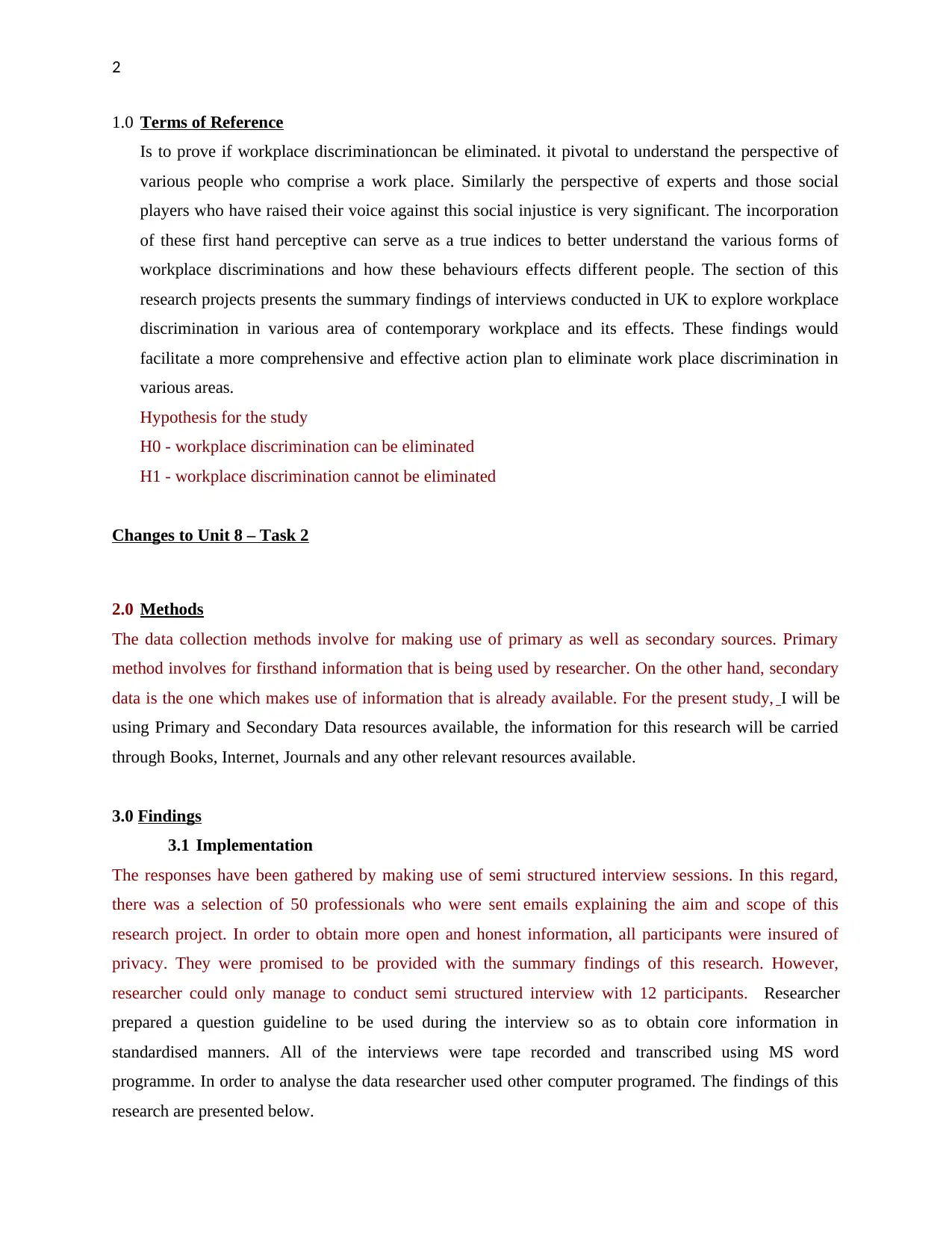
2
1.0 Terms of Reference
Is to prove if workplace discriminationcan be eliminated. it pivotal to understand the perspective of
various people who comprise a work place. Similarly the perspective of experts and those social
players who have raised their voice against this social injustice is very significant. The incorporation
of these first hand perceptive can serve as a true indices to better understand the various forms of
workplace discriminations and how these behaviours effects different people. The section of this
research projects presents the summary findings of interviews conducted in UK to explore workplace
discrimination in various area of contemporary workplace and its effects. These findings would
facilitate a more comprehensive and effective action plan to eliminate work place discrimination in
various areas.
Hypothesis for the study
H0 - workplace discrimination can be eliminated
H1 - workplace discrimination cannot be eliminated
Changes to Unit 8 – Task 2
2.0 Methods
The data collection methods involve for making use of primary as well as secondary sources. Primary
method involves for firsthand information that is being used by researcher. On the other hand, secondary
data is the one which makes use of information that is already available. For the present study, I will be
using Primary and Secondary Data resources available, the information for this research will be carried
through Books, Internet, Journals and any other relevant resources available.
3.0 Findings
3.1 Implementation
The responses have been gathered by making use of semi structured interview sessions. In this regard,
there was a selection of 50 professionals who were sent emails explaining the aim and scope of this
research project. In order to obtain more open and honest information, all participants were insured of
privacy. They were promised to be provided with the summary findings of this research. However,
researcher could only manage to conduct semi structured interview with 12 participants. Researcher
prepared a question guideline to be used during the interview so as to obtain core information in
standardised manners. All of the interviews were tape recorded and transcribed using MS word
programme. In order to analyse the data researcher used other computer programed. The findings of this
research are presented below.
1.0 Terms of Reference
Is to prove if workplace discriminationcan be eliminated. it pivotal to understand the perspective of
various people who comprise a work place. Similarly the perspective of experts and those social
players who have raised their voice against this social injustice is very significant. The incorporation
of these first hand perceptive can serve as a true indices to better understand the various forms of
workplace discriminations and how these behaviours effects different people. The section of this
research projects presents the summary findings of interviews conducted in UK to explore workplace
discrimination in various area of contemporary workplace and its effects. These findings would
facilitate a more comprehensive and effective action plan to eliminate work place discrimination in
various areas.
Hypothesis for the study
H0 - workplace discrimination can be eliminated
H1 - workplace discrimination cannot be eliminated
Changes to Unit 8 – Task 2
2.0 Methods
The data collection methods involve for making use of primary as well as secondary sources. Primary
method involves for firsthand information that is being used by researcher. On the other hand, secondary
data is the one which makes use of information that is already available. For the present study, I will be
using Primary and Secondary Data resources available, the information for this research will be carried
through Books, Internet, Journals and any other relevant resources available.
3.0 Findings
3.1 Implementation
The responses have been gathered by making use of semi structured interview sessions. In this regard,
there was a selection of 50 professionals who were sent emails explaining the aim and scope of this
research project. In order to obtain more open and honest information, all participants were insured of
privacy. They were promised to be provided with the summary findings of this research. However,
researcher could only manage to conduct semi structured interview with 12 participants. Researcher
prepared a question guideline to be used during the interview so as to obtain core information in
standardised manners. All of the interviews were tape recorded and transcribed using MS word
programme. In order to analyse the data researcher used other computer programed. The findings of this
research are presented below.
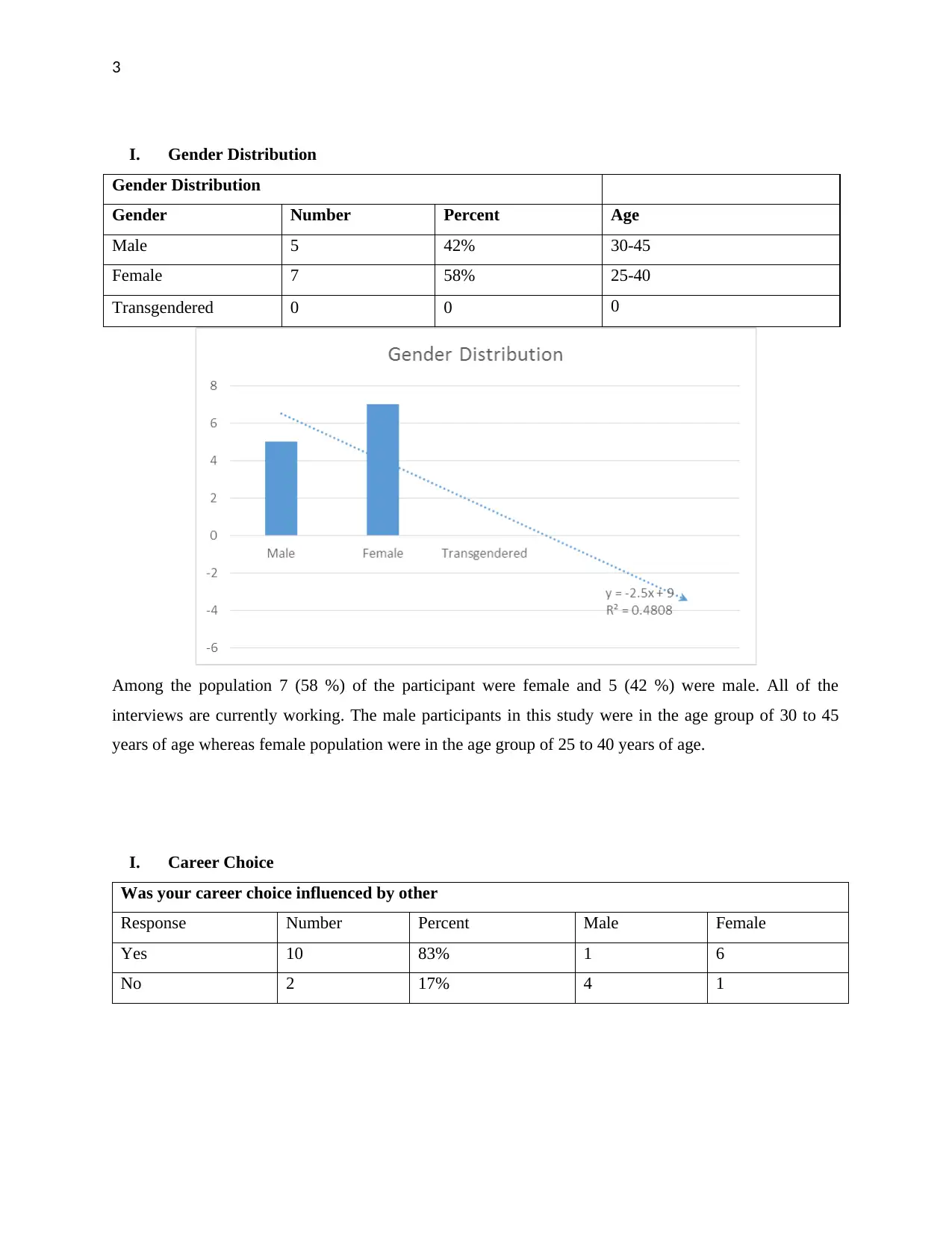
3
I. Gender Distribution
Gender Distribution
Gender Number Percent Age
Male 5 42% 30-45
Female 7 58% 25-40
Transgendered 0 0 0
Among the population 7 (58 %) of the participant were female and 5 (42 %) were male. All of the
interviews are currently working. The male participants in this study were in the age group of 30 to 45
years of age whereas female population were in the age group of 25 to 40 years of age.
I. Career Choice
Was your career choice influenced by other
Response Number Percent Male Female
Yes 10 83% 1 6
No 2 17% 4 1
I. Gender Distribution
Gender Distribution
Gender Number Percent Age
Male 5 42% 30-45
Female 7 58% 25-40
Transgendered 0 0 0
Among the population 7 (58 %) of the participant were female and 5 (42 %) were male. All of the
interviews are currently working. The male participants in this study were in the age group of 30 to 45
years of age whereas female population were in the age group of 25 to 40 years of age.
I. Career Choice
Was your career choice influenced by other
Response Number Percent Male Female
Yes 10 83% 1 6
No 2 17% 4 1
⊘ This is a preview!⊘
Do you want full access?
Subscribe today to unlock all pages.

Trusted by 1+ million students worldwide
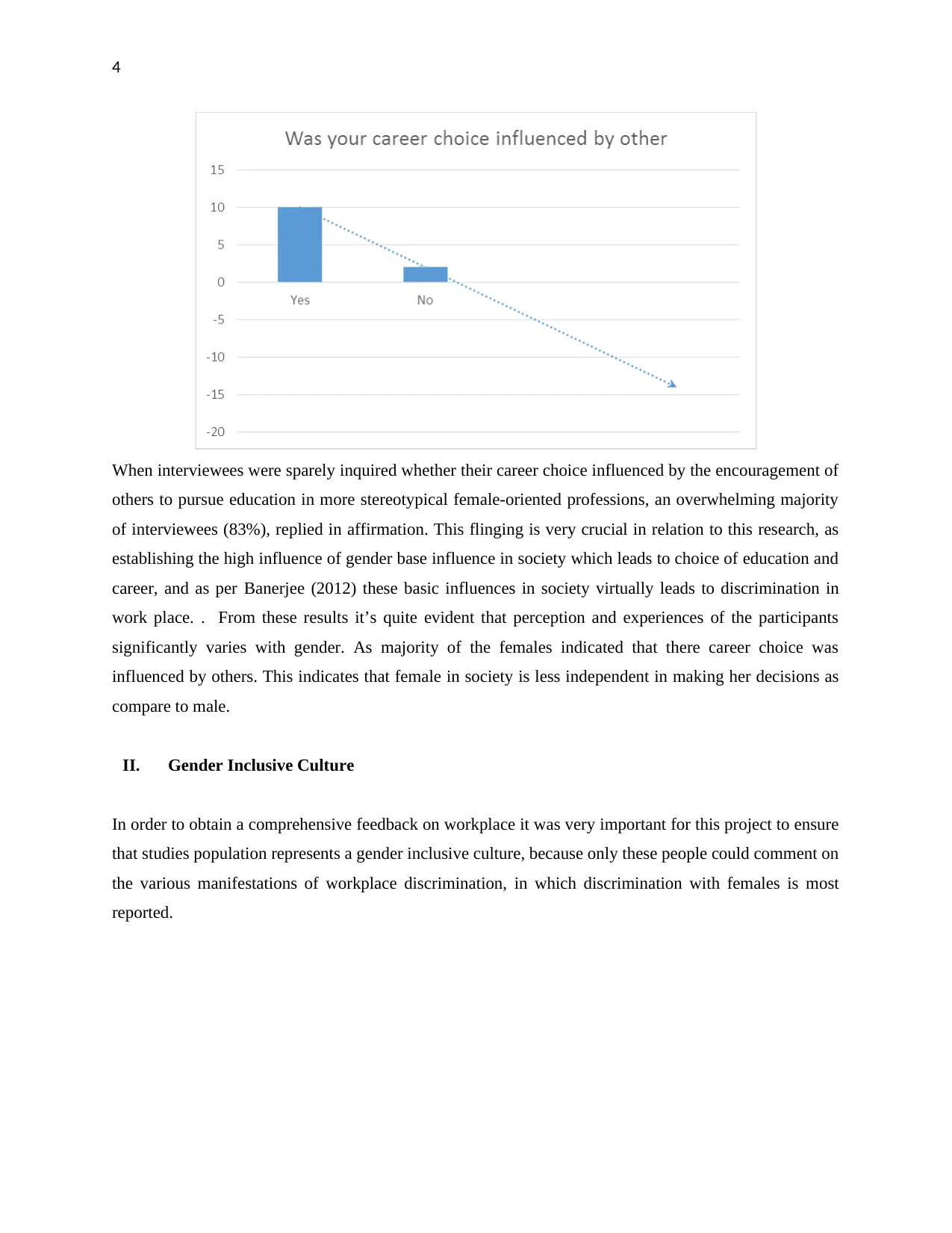
4
When interviewees were sparely inquired whether their career choice influenced by the encouragement of
others to pursue education in more stereotypical female-oriented professions, an overwhelming majority
of interviewees (83%), replied in affirmation. This flinging is very crucial in relation to this research, as
establishing the high influence of gender base influence in society which leads to choice of education and
career, and as per Banerjee (2012) these basic influences in society virtually leads to discrimination in
work place. . From these results it’s quite evident that perception and experiences of the participants
significantly varies with gender. As majority of the females indicated that there career choice was
influenced by others. This indicates that female in society is less independent in making her decisions as
compare to male.
II. Gender Inclusive Culture
In order to obtain a comprehensive feedback on workplace it was very important for this project to ensure
that studies population represents a gender inclusive culture, because only these people could comment on
the various manifestations of workplace discrimination, in which discrimination with females is most
reported.
When interviewees were sparely inquired whether their career choice influenced by the encouragement of
others to pursue education in more stereotypical female-oriented professions, an overwhelming majority
of interviewees (83%), replied in affirmation. This flinging is very crucial in relation to this research, as
establishing the high influence of gender base influence in society which leads to choice of education and
career, and as per Banerjee (2012) these basic influences in society virtually leads to discrimination in
work place. . From these results it’s quite evident that perception and experiences of the participants
significantly varies with gender. As majority of the females indicated that there career choice was
influenced by others. This indicates that female in society is less independent in making her decisions as
compare to male.
II. Gender Inclusive Culture
In order to obtain a comprehensive feedback on workplace it was very important for this project to ensure
that studies population represents a gender inclusive culture, because only these people could comment on
the various manifestations of workplace discrimination, in which discrimination with females is most
reported.
Paraphrase This Document
Need a fresh take? Get an instant paraphrase of this document with our AI Paraphraser
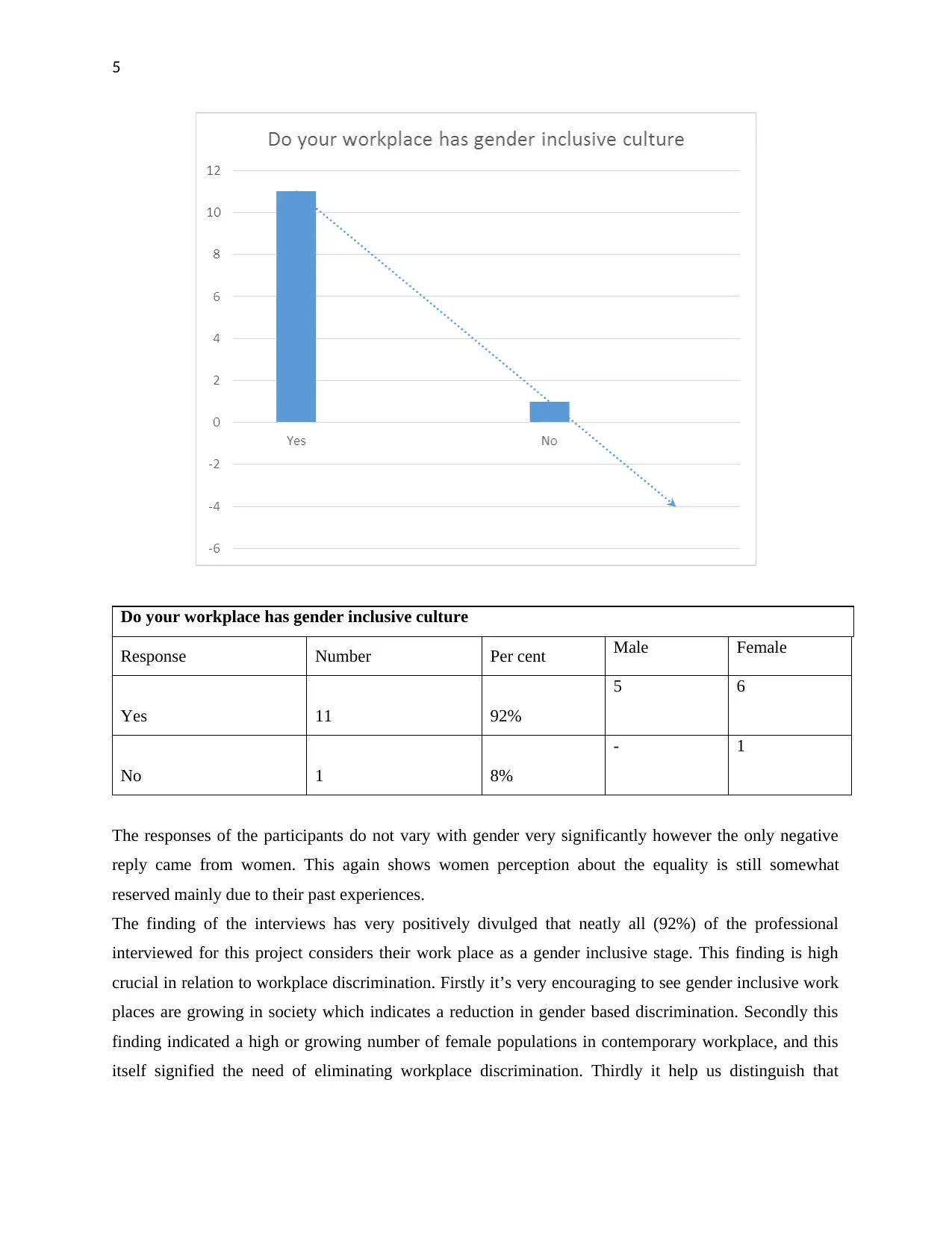
5
Do your workplace has gender inclusive culture
Response Number Per cent Male Female
Yes 11 92%
5 6
No 1 8%
- 1
The responses of the participants do not vary with gender very significantly however the only negative
reply came from women. This again shows women perception about the equality is still somewhat
reserved mainly due to their past experiences.
The finding of the interviews has very positively divulged that neatly all (92%) of the professional
interviewed for this project considers their work place as a gender inclusive stage. This finding is high
crucial in relation to workplace discrimination. Firstly it’s very encouraging to see gender inclusive work
places are growing in society which indicates a reduction in gender based discrimination. Secondly this
finding indicated a high or growing number of female populations in contemporary workplace, and this
itself signified the need of eliminating workplace discrimination. Thirdly it help us distinguish that
Do your workplace has gender inclusive culture
Response Number Per cent Male Female
Yes 11 92%
5 6
No 1 8%
- 1
The responses of the participants do not vary with gender very significantly however the only negative
reply came from women. This again shows women perception about the equality is still somewhat
reserved mainly due to their past experiences.
The finding of the interviews has very positively divulged that neatly all (92%) of the professional
interviewed for this project considers their work place as a gender inclusive stage. This finding is high
crucial in relation to workplace discrimination. Firstly it’s very encouraging to see gender inclusive work
places are growing in society which indicates a reduction in gender based discrimination. Secondly this
finding indicated a high or growing number of female populations in contemporary workplace, and this
itself signified the need of eliminating workplace discrimination. Thirdly it help us distinguish that
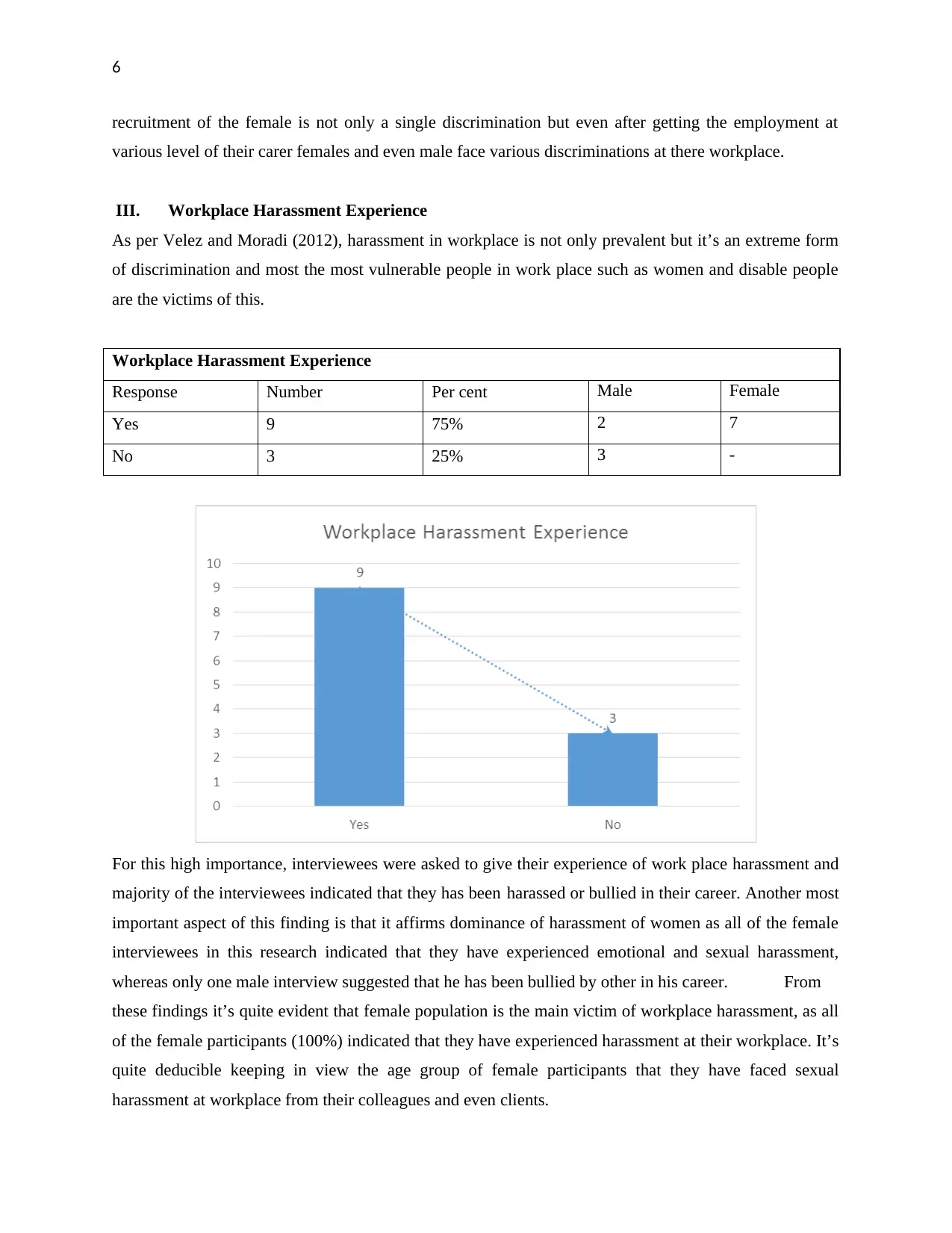
6
recruitment of the female is not only a single discrimination but even after getting the employment at
various level of their carer females and even male face various discriminations at there workplace.
III. Workplace Harassment Experience
As per Velez and Moradi (2012), harassment in workplace is not only prevalent but it’s an extreme form
of discrimination and most the most vulnerable people in work place such as women and disable people
are the victims of this.
Workplace Harassment Experience
Response Number Per cent Male Female
Yes 9 75% 2 7
No 3 25% 3 -
For this high importance, interviewees were asked to give their experience of work place harassment and
majority of the interviewees indicated that they has been harassed or bullied in their career. Another most
important aspect of this finding is that it affirms dominance of harassment of women as all of the female
interviewees in this research indicated that they have experienced emotional and sexual harassment,
whereas only one male interview suggested that he has been bullied by other in his career. From
these findings it’s quite evident that female population is the main victim of workplace harassment, as all
of the female participants (100%) indicated that they have experienced harassment at their workplace. It’s
quite deducible keeping in view the age group of female participants that they have faced sexual
harassment at workplace from their colleagues and even clients.
recruitment of the female is not only a single discrimination but even after getting the employment at
various level of their carer females and even male face various discriminations at there workplace.
III. Workplace Harassment Experience
As per Velez and Moradi (2012), harassment in workplace is not only prevalent but it’s an extreme form
of discrimination and most the most vulnerable people in work place such as women and disable people
are the victims of this.
Workplace Harassment Experience
Response Number Per cent Male Female
Yes 9 75% 2 7
No 3 25% 3 -
For this high importance, interviewees were asked to give their experience of work place harassment and
majority of the interviewees indicated that they has been harassed or bullied in their career. Another most
important aspect of this finding is that it affirms dominance of harassment of women as all of the female
interviewees in this research indicated that they have experienced emotional and sexual harassment,
whereas only one male interview suggested that he has been bullied by other in his career. From
these findings it’s quite evident that female population is the main victim of workplace harassment, as all
of the female participants (100%) indicated that they have experienced harassment at their workplace. It’s
quite deducible keeping in view the age group of female participants that they have faced sexual
harassment at workplace from their colleagues and even clients.
⊘ This is a preview!⊘
Do you want full access?
Subscribe today to unlock all pages.

Trusted by 1+ million students worldwide
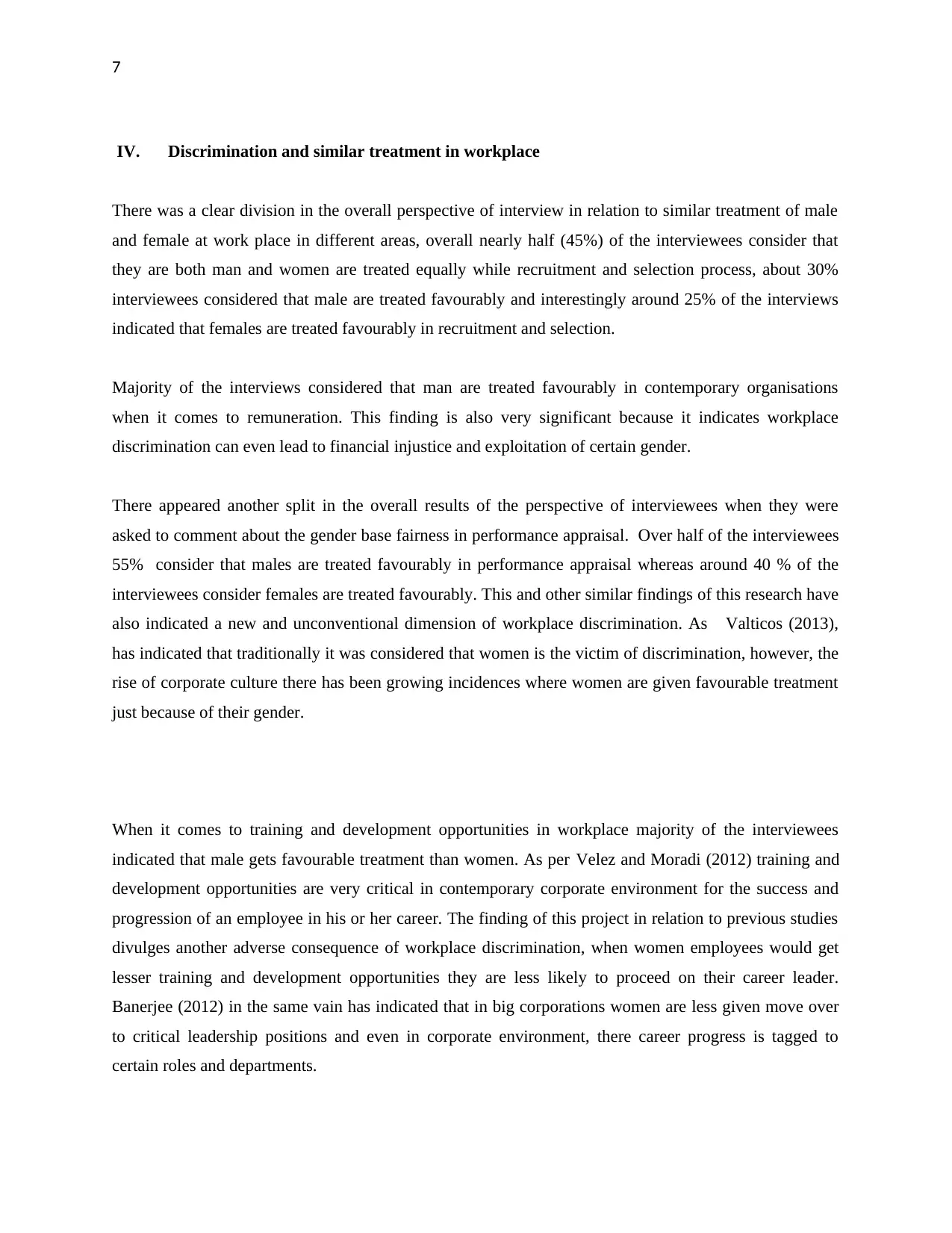
7
IV. Discrimination and similar treatment in workplace
There was a clear division in the overall perspective of interview in relation to similar treatment of male
and female at work place in different areas, overall nearly half (45%) of the interviewees consider that
they are both man and women are treated equally while recruitment and selection process, about 30%
interviewees considered that male are treated favourably and interestingly around 25% of the interviews
indicated that females are treated favourably in recruitment and selection.
Majority of the interviews considered that man are treated favourably in contemporary organisations
when it comes to remuneration. This finding is also very significant because it indicates workplace
discrimination can even lead to financial injustice and exploitation of certain gender.
There appeared another split in the overall results of the perspective of interviewees when they were
asked to comment about the gender base fairness in performance appraisal. Over half of the interviewees
55% consider that males are treated favourably in performance appraisal whereas around 40 % of the
interviewees consider females are treated favourably. This and other similar findings of this research have
also indicated a new and unconventional dimension of workplace discrimination. As Valticos (2013),
has indicated that traditionally it was considered that women is the victim of discrimination, however, the
rise of corporate culture there has been growing incidences where women are given favourable treatment
just because of their gender.
When it comes to training and development opportunities in workplace majority of the interviewees
indicated that male gets favourable treatment than women. As per Velez and Moradi (2012) training and
development opportunities are very critical in contemporary corporate environment for the success and
progression of an employee in his or her career. The finding of this project in relation to previous studies
divulges another adverse consequence of workplace discrimination, when women employees would get
lesser training and development opportunities they are less likely to proceed on their career leader.
Banerjee (2012) in the same vain has indicated that in big corporations women are less given move over
to critical leadership positions and even in corporate environment, there career progress is tagged to
certain roles and departments.
IV. Discrimination and similar treatment in workplace
There was a clear division in the overall perspective of interview in relation to similar treatment of male
and female at work place in different areas, overall nearly half (45%) of the interviewees consider that
they are both man and women are treated equally while recruitment and selection process, about 30%
interviewees considered that male are treated favourably and interestingly around 25% of the interviews
indicated that females are treated favourably in recruitment and selection.
Majority of the interviews considered that man are treated favourably in contemporary organisations
when it comes to remuneration. This finding is also very significant because it indicates workplace
discrimination can even lead to financial injustice and exploitation of certain gender.
There appeared another split in the overall results of the perspective of interviewees when they were
asked to comment about the gender base fairness in performance appraisal. Over half of the interviewees
55% consider that males are treated favourably in performance appraisal whereas around 40 % of the
interviewees consider females are treated favourably. This and other similar findings of this research have
also indicated a new and unconventional dimension of workplace discrimination. As Valticos (2013),
has indicated that traditionally it was considered that women is the victim of discrimination, however, the
rise of corporate culture there has been growing incidences where women are given favourable treatment
just because of their gender.
When it comes to training and development opportunities in workplace majority of the interviewees
indicated that male gets favourable treatment than women. As per Velez and Moradi (2012) training and
development opportunities are very critical in contemporary corporate environment for the success and
progression of an employee in his or her career. The finding of this project in relation to previous studies
divulges another adverse consequence of workplace discrimination, when women employees would get
lesser training and development opportunities they are less likely to proceed on their career leader.
Banerjee (2012) in the same vain has indicated that in big corporations women are less given move over
to critical leadership positions and even in corporate environment, there career progress is tagged to
certain roles and departments.
Paraphrase This Document
Need a fresh take? Get an instant paraphrase of this document with our AI Paraphraser
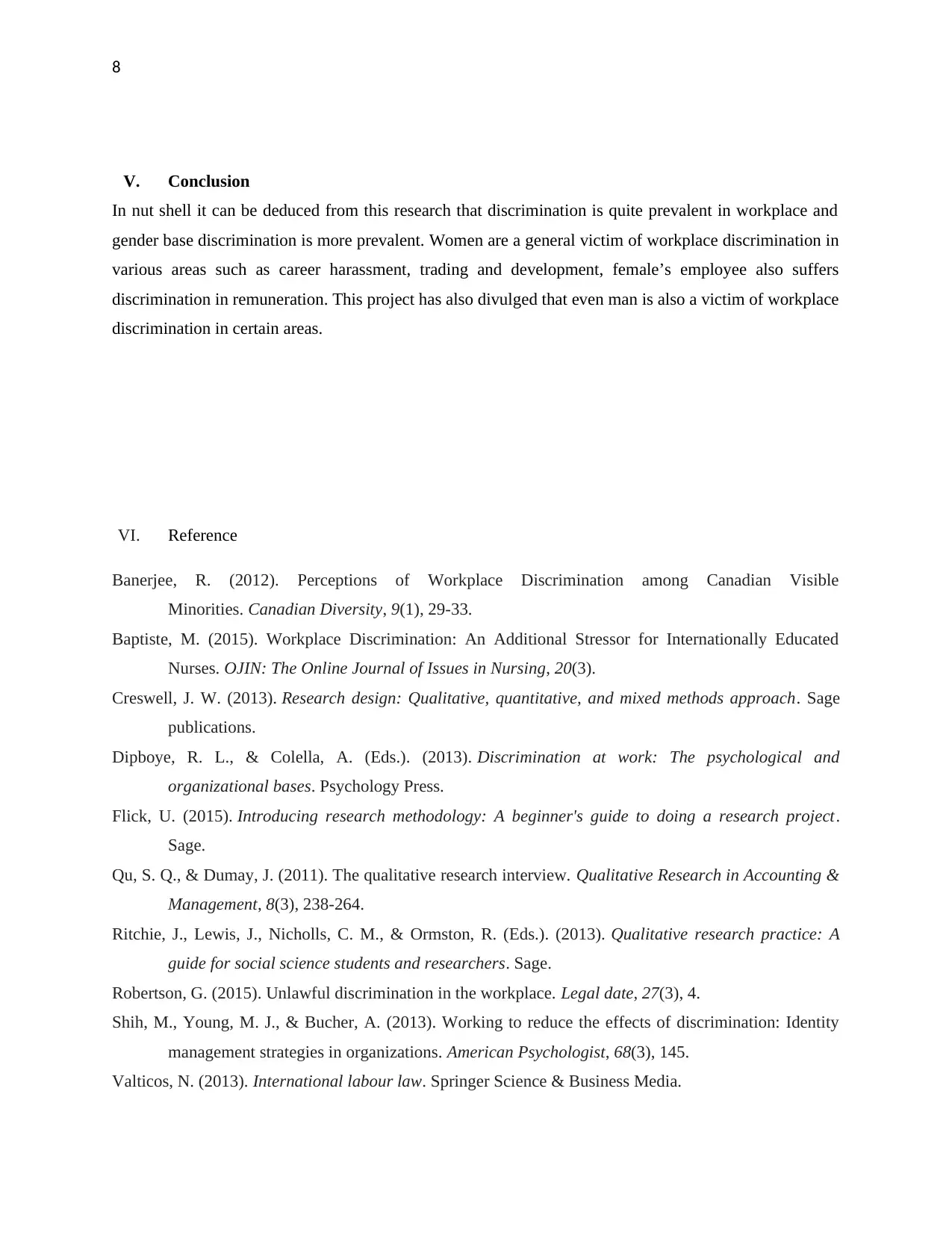
8
V. Conclusion
In nut shell it can be deduced from this research that discrimination is quite prevalent in workplace and
gender base discrimination is more prevalent. Women are a general victim of workplace discrimination in
various areas such as career harassment, trading and development, female’s employee also suffers
discrimination in remuneration. This project has also divulged that even man is also a victim of workplace
discrimination in certain areas.
VI. Reference
Banerjee, R. (2012). Perceptions of Workplace Discrimination among Canadian Visible
Minorities. Canadian Diversity, 9(1), 29-33.
Baptiste, M. (2015). Workplace Discrimination: An Additional Stressor for Internationally Educated
Nurses. OJIN: The Online Journal of Issues in Nursing, 20(3).
Creswell, J. W. (2013). Research design: Qualitative, quantitative, and mixed methods approach. Sage
publications.
Dipboye, R. L., & Colella, A. (Eds.). (2013). Discrimination at work: The psychological and
organizational bases. Psychology Press.
Flick, U. (2015). Introducing research methodology: A beginner's guide to doing a research project.
Sage.
Qu, S. Q., & Dumay, J. (2011). The qualitative research interview. Qualitative Research in Accounting &
Management, 8(3), 238-264.
Ritchie, J., Lewis, J., Nicholls, C. M., & Ormston, R. (Eds.). (2013). Qualitative research practice: A
guide for social science students and researchers. Sage.
Robertson, G. (2015). Unlawful discrimination in the workplace. Legal date, 27(3), 4.
Shih, M., Young, M. J., & Bucher, A. (2013). Working to reduce the effects of discrimination: Identity
management strategies in organizations. American Psychologist, 68(3), 145.
Valticos, N. (2013). International labour law. Springer Science & Business Media.
V. Conclusion
In nut shell it can be deduced from this research that discrimination is quite prevalent in workplace and
gender base discrimination is more prevalent. Women are a general victim of workplace discrimination in
various areas such as career harassment, trading and development, female’s employee also suffers
discrimination in remuneration. This project has also divulged that even man is also a victim of workplace
discrimination in certain areas.
VI. Reference
Banerjee, R. (2012). Perceptions of Workplace Discrimination among Canadian Visible
Minorities. Canadian Diversity, 9(1), 29-33.
Baptiste, M. (2015). Workplace Discrimination: An Additional Stressor for Internationally Educated
Nurses. OJIN: The Online Journal of Issues in Nursing, 20(3).
Creswell, J. W. (2013). Research design: Qualitative, quantitative, and mixed methods approach. Sage
publications.
Dipboye, R. L., & Colella, A. (Eds.). (2013). Discrimination at work: The psychological and
organizational bases. Psychology Press.
Flick, U. (2015). Introducing research methodology: A beginner's guide to doing a research project.
Sage.
Qu, S. Q., & Dumay, J. (2011). The qualitative research interview. Qualitative Research in Accounting &
Management, 8(3), 238-264.
Ritchie, J., Lewis, J., Nicholls, C. M., & Ormston, R. (Eds.). (2013). Qualitative research practice: A
guide for social science students and researchers. Sage.
Robertson, G. (2015). Unlawful discrimination in the workplace. Legal date, 27(3), 4.
Shih, M., Young, M. J., & Bucher, A. (2013). Working to reduce the effects of discrimination: Identity
management strategies in organizations. American Psychologist, 68(3), 145.
Valticos, N. (2013). International labour law. Springer Science & Business Media.
1 out of 8
Related Documents
Your All-in-One AI-Powered Toolkit for Academic Success.
+13062052269
info@desklib.com
Available 24*7 on WhatsApp / Email
![[object Object]](/_next/static/media/star-bottom.7253800d.svg)
Unlock your academic potential
Copyright © 2020–2025 A2Z Services. All Rights Reserved. Developed and managed by ZUCOL.





